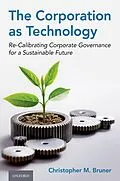Recent decades have witnessed environmental, social, and economic upheaval, with major corporations contributing to a host of interconnected crises. The Corporation as Technology examines the dynamics of the corporate form and corporate law that incentivize harmful excesses and presents an alternative vision to render corporate activities more sustainable. The corporate form is commonly described as a set of fixed characteristics that strongly prioritize shareholders' interests. This book subverts this widely held belief, suggesting that such rigid depictions reinforce harmful corporate pathologies, including excessive risk-taking and lack of regard for environmental and social impacts. Instead, corporations are presented as a dynamic legal technology that policymakers can re-calibrate over time in response to changing landscapes. This book explores the theoretical and practical ramifications of this alternative vision, focusing on how the corporate form can help secure an environmentally, socially, and economically sustainable future.
Autorentext
Christopher M. Bruner is the Stembler Family Distinguished Professor in Business Law at the University of Georgia School of Law. His scholarship focuses on corporate law, corporate governance, comparative law, and sustainability, and he has written several books on these topics. He received his A.B., M.Phil., and J.D. from the University of Michigan, the University of Oxford, and Harvard Law School, respectively.
Inhalt
PART ONE: THE DYNAMISM OF THE CORPORATION Chapter 1. Introduction and Overview Chapter 2. Defining the Corporation and Corporate Law Chapter 3. Contextual Drivers of Difference PART TWO: RE-CONCEPTUALIZING THE CORPORATION Chapter 4. Enduring Controversies in Corporate Law Chapter 5. The Corporation as Technology PART THREE: HARNESSING THE CORPORATION Chapter 6. Corporate Pathologies and Corporate Sustainability Chapter 7. Re-Calibrating Governance: Industry-by-Industry Approaches Chapter 8. Re-Imagining Corporate Accountability Chapter 9. Conclusions
